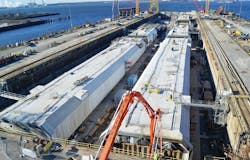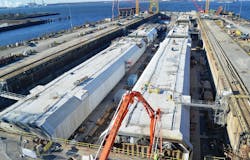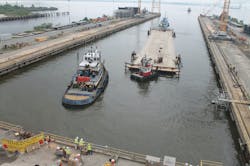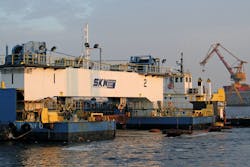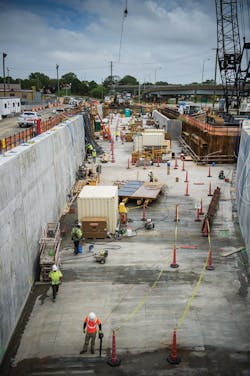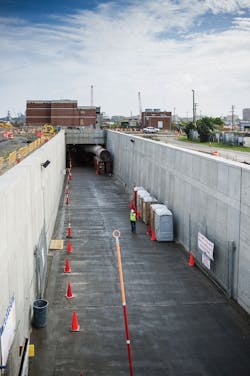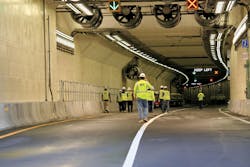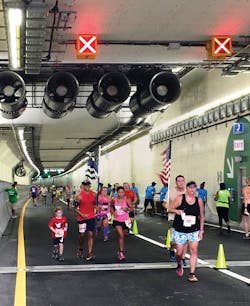Deep impact
Until recently, the Midtown Tunnel connecting Norfolk and Portsmouth, Va., held the distinction of being considered the most heavily traveled two-lane road east of the Mississippi River.
In the more than 50 years since its original construction, traffic volume has risen from 8,400 vehicles per day to nearly 40,000 per day in 2013. By 2026, nearly 50,000 vehicles are projected to pass through it each day.
Now, however, the Midtown Tunnel holds a new distinction. It represents the successful completion of one of the country’s first all-concrete, deep-water, immersed tube tunnels, and serves as an example of a successful and effective public-private partnership (P3).
SKW Constructors, a joint venture of Skanska USA Civil Southeast Inc. (the lead partner), Kiewit Infrastructure Co., and Weeks Marine Inc., recently completed construction of a new 3,800-ft-long, two-lane tunnel adjacent to the existing Midtown Tunnel—and opened it to traffic six months ahead of schedule.
Casting of Tunnel Elements 7-11 at Sparrows Point, Md., graving dock.
Overview
The new Midtown Tunnel is part of the larger Elizabeth River Tunnels (ERT) project, one of the largest P3s in the U.S. The ERT project involves the development, finance, design-build, and operation and maintenance of four Hampton Roads regional transportation infrastructure assets. First is the new two-lane tunnel adjacent to the existing Midtown Tunnel. In addition, SKW is making life-safety and maintenance improvements not only to the Midtown Tunnel, but to two Downtown Tunnels as well. It also is extending the MLK Freeway in Portsmouth from London Boulevard to I-264. Finally, it is modifying the Brambleton Avenue and Hampton Boulevard interchange in Norfolk leading into and out of the Midtown Tunnel.
This $2.1 billion project is the first P3 deep-water tunnel project in the U.S. Under a comprehensive agreement, the Virginia Department of Transportation (VDOT) will maintain ownership of the infrastructure and oversee the activities of Elizabeth River Crossings OpCo LLC (ERC), a sole-purpose company created to finance, deliver, operate and maintain the Elizabeth River Tunnels Project for the 58-year concession, including collecting and operating the tolling system.
Tunnel Element 6 being floated out of dry dock in Sparrows Point, Md.
Meeting challenges
The Midtown Tunnel project presented a number of technical and logistical challenges. The first challenge came in dredging the trench in which the tunnel would be placed. Using a large crane and clamshell bucket, trenches were excavated on land and at the bottom of the Elizabeth River, driving down through riverbed in water up to 95 ft deep. In the process, crews removed existing abandoned timber piles and shoreline debris, along with 1.5 million cu yd of sediment from the water. After excavating the full trench, a 3-ft gravel bed (with an elevation tolerance of ±1 in.) was placed in the bottom of the trench (95 ft underwater from a floating vessel) for the tunnel elements to rest on. The level of precision here was predicated on successful planning and design.
Positioning the closure piece of the tunnel elements presented its own challenges. Rather than having the tunnel elements meet in the middle of the river with a closure piece, contractors decided to move the closure to the Norfolk end of the tunnel, which allowed the team to tie in the last tunnel element and the Norfolk Approach in a dry environment, without negatively impacting naval and commercial marine traffic in the channel.
Lay barge positioning Tunnel Element 6 for immersion in the Elizabeth River.
The tunnel itself is made up of 11 precast concrete, rectangular elements, each approximately 342 ft long, 28.5 ft tall and 54 ft wide, and weighing 16,000 tons. The formulation and selection of the best concrete mix, intended to satisfy a 120-year lifespan requirement, required each element to be cast in a graving dock at Sparrows Point, near Baltimore, and subsequently floated 200 nautical miles down the Chesapeake Bay to the construction site in Portsmouth.
The concrete had to have a service life of 120 years in an extremely corrosive environment without the use of corrosion inhibitors; it had to reach 6,000 psi in 28 days; and needed to be extremely durable yet flowable enough to accommodate double and triple mats of No. 11 black rebar.
Once the precast elements arrived on-site, they were prepared for immersion and then placed in a large catamaran-style lay barge, which was used to control their descent to the bottom of the river through the use of ballast. The precise placement of the elements was controlled from the lay barge, with divers checking the work underwater once the elements were resting on the bottom of the excavated trench.
Welding being performed in the new Midtown Tunnel.
A significant challenge to be addressed was the “sealing” of the elements, once in position at the bottom of the river, to keep them watertight. To achieve this, a steel ring on one end of an element was placed next to an “O ring,” or “Gina gasket” on the end of an adjacent element. Once the elements were connected, water from between the bulkheads was removed and the resulting vacuum squeezed the gasket to create the watertight seal.
As crews placed each newly immersed element adjacent to a previously immersed and positioned element, the Gina gasket compressed; then another rubber seal, an Omega gasket, was placed on the inside junction of the elements, which would enable the tunnel to handle twice its expected load. After the team verified the secure placement and functionality of the Gina and Omega gaskets, the junctions were encased in concrete to provide a structural cover.
A view from the cut-and-cover section of the Norfolk Approach looking east towards the opening of the approach.
By using a precast concrete tunnel, SKW was afforded the additional benefit of reducing the overall height of the tunnel elements. This allowed for less dredging, making the project more economical, and it allowed for more flexibility in design and transport.
Following the placement of the tunnel elements in position at the bottom of the Elizabeth River, SKW removed the ballast water, poured concrete in the bottom of the tunnel (to create the curvature of the road), and then paved the road surface on top. For the driving layer, an asphalt specification of SM-9.5 E was applied at a thickness of 3 in. throughout the length of the tunnel. The choice of an asphalt driving surface came down to repairability and noise control, given the enclosed environment. Crews applied a three-part backfill operation along the sides and top of the immersed tunnel elements to prevent horizontal movement, provide a protective cover, and add an additional layer of protection against scour and marine impacts.
A view from the opening of the Portsmouth Approach looking east towards the Portsmouth entrance of the new Midtown Tunnel.
The bigger picture
Now that work on the new tunnel has been completed, the focus has shifted to the rehabilitation of the existing Midtown Tunnel to perform maintenance and make life-safety improvements—including the installation of a fire-protection board to the ceiling, the installation of jet fans to replace and enhance the tunnel ventilation system, the upgrading of the tunnel lighting system with LED lights, and the installation of a new traffic management system.
Rehabilitation of the Downtown Tunnels, both eastbound and westbound tubes, to perform maintenance and make life-safety improvements, was started in August 2013 and completed in August 2016. In an effort to decrease the construction time on the rehabilitation of the existing tunnels, crews got underway while the new tunnel was under construction, maintaining evening and weekend shifts. Consequently, rehabilitation of the Downtown Tunnels was completed four months ahead of schedule.
Construction activities on the MLK Freeway Extension in Portsmouth began in November 2013. Planned work included widening of the roadway and bridges on I-264, replacing the pedestrian bridge over I-264, extending the MLK Freeway from London Boulevard to I-264 via an elevated highway with an interchange at High Street, and installing aesthetic treatments from Turnpike Road to London Boulevard.
Members of the SKW Constructors team (the design-build contractor for the new Midtown Tunnel) do one final walk-through of the new tunnel just prior to being opened to traffic.
Extending the MLK Freeway from London Boulevard (where it currently terminates) to I-264 will provide a more direct access between the Midtown and Downtown tunnels and add a shorter, more direct route to the Downtown Tunnel from Portsmouth. It also will allow motorists to easily choose between the Midtown or Downtown tunnels, and better communicate traffic conditions via changeable message signs on the MLK Freeway. Initially planned for completion in August 2018, the job is now expected to be completed almost one full year early, the result of managing and mitigating the risks inherent in a design-build project of this magnitude, and performing continuous planning revisions and updates as needed.
When the ERT project is fully completed, the average round-trip commuter will save about 30 minutes a day. This will not only save time, but also reduce fuel consumption and emissions. Roadway safety will improve with the elimination of bi-directional traffic in the existing Midtown Tunnel by separating traffic into two, two-lane, unidirectional tunnels—the existing, rehabilitated Midtown Tunnel will carry two lanes of eastbound traffic from Portsmouth into Norfolk, while the new Midtown Tunnel will carry two lanes of westbound traffic from Norfolk into Portsmouth.
The P3 component will continue to play a key role in the life-cycle maintenance of the tunnels. Since it is locked in for the long term, regular maintenance is now guaranteed and unaffected by future budgetary changes.
Overall, the region is expected to flourish as a result of this endeavor. Greater ease of travel and increased travel options, thanks in part to an increase in the frequency of mass transit routes, will provide greater accessibility to jobs, educational institutions, healthcare facilities, shopping and recreational activities. This has great significance to the Hampton Roads area, a region of more than 1.7 million people that also is home to Naval Station Norfolk, the world’s largest naval base, as well as several marine terminals in Portsmouth and Norfolk. Successful completion of the Elizabeth River Tunnels project will prove critical for motorists, the region’s economy, the efficient movement of goods and services, and the quality of life in Hampton Roads.
Runners participate in the Elizabeth River Tunnels 5k Run/Walk—one of the new Midtown Tunnel opening events.
